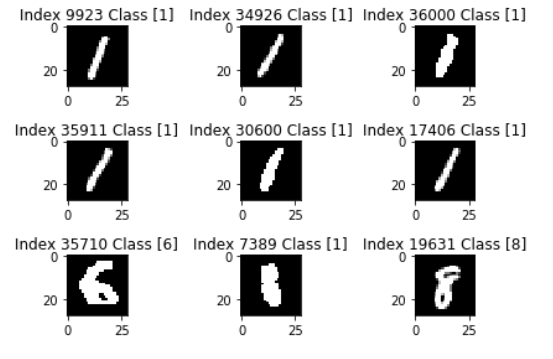K 近鄰演算法識別手寫數字(Numpy寫法)
阿新 • • 發佈:2018-12-08
在 Kaggle 上面的 Notebook 給可愛的學弟學妹們用於參考... 程式碼這個東西一定要自己多寫,我一邊聽著林宥嘉的《想自由》,一邊寫出了大致的實現。K 近鄰演算法大概做的是一件什麼事情呢?你去商店買衣服的時候,突然忘記了自己要買的衣服多大尺碼比較合適(S/M/L/XL 這種)。這個時候你就要找幾個身材和你差不多的幾個店內顧客問一問了,結果你發現你這樣的身材的人大多買的是 XL 的衣服,所以你最後告訴老闆你也買 XL 的衣服,果然是機智聰明啊。
下面是解決該問題的思路重點:
- 你需要找幾個身材和你相似的人?(K 的個數)
- 你是怎麼判斷其它人身材和你的相似程度的?(距離度量方式)
- 你最終參考的是最多被購買的尺碼。(畢竟不同的人建議可能不同)
關於資料集的讀入
MNIST 資料集可以在這裡獲取:THE MNIST DATABASE of handwritten digits . 你一定很好奇——為什麼在 Kaggle 裡面資料集是 CSV 格式,而在資料集官網提供的是四個壓縮檔案?這沒什麼好稀奇的,你只需要根據不同的資料格式採用不同的資料讀取套路就好了,只要最後的資料格式的維度一致即可。
資料集已經解壓
def load_mnist(path, kind='train'): """Load MNIST data from `path`""" labels_path = os.path.join(path,'%s-labels-idx1-ubyte'% kind) images_path = os.path.join(path,'%s-images-idx3-ubyte'% kind) with open(labels_path,'rb') as lbpath: labels = np.frombuffer(lbpath.read(), dtype=np.uint8, offset=8) with open(images_path,'rb') as imgpath: images = np.frombuffer(imgpath.read(), dtype=np.uint8, offset=16).reshape(len(labels), 784) return images, labels
資料集未解壓
def load_mnist(path, kind='train'): """Load MNIST data from `path`""" labels_path = os.path.join(path, '%s-labels-idx1-ubyte.gz' % kind) images_path = os.path.join(path, '%s-images-idx3-ubyte.gz' % kind) with gzip.open(labels_path, 'rb') as lbpath: labels = np.frombuffer(lbpath.read(), dtype=np.uint8, offset=8) with gzip.open(images_path, 'rb') as imgpath: images = np.frombuffer(imgpath.read(), dtype=np.uint8, offset=16).reshape(len(labels), 784) return images, labels
資料集已經被轉為 CSV 格式且無測試集標籤(Kaggle)
# It will takes about 1 ~ 2 minutes (depends on CPU)
train_data = np.genfromtxt('../input/train.csv', delimiter=',',
skip_header=1).astype(np.dtype('uint8'))
X_train = train_data[:,1:]
y_train = train_data[:,:1]
X_test = np.genfromtxt('../input/test.csv', delimiter=',',
skip_header=1).astype(np.dtype('uint8'))檢查資料匯入是否順利
np.random.seed(0);
indices = list(np.random.randint(m_train, size=9))
for i in range(9):
plt.subplot(3,3,i + 1)
plt.imshow(X_train[indices[i]].reshape(28,28), cmap='gray', interpolation='none')
plt.title("Index {} Class {}".format(indices[i], y_train[indices[i]]))
plt.tight_layout()
定義距離度量
def euclidean_distance(vector1, vector2):
return np.sqrt(np.sum(np.power(vector1 - vector2, 2)))
def absolute_distance(vector1, vector2):
return np.sum(np.absolute(vector1 - vector2))找相似鄰居(K Neighbours)
import operator
def get_neighbours(X_train, test_instance, k):
distances = []
neighbors = []
for i in range(0, X_train.shape[0]):
dist = euclidean_distance(X_train[i], test_instance)
distances.append((i, dist))
distances.sort(key=operator.itemgetter(1))
for x in range(k):
# print(distances[x])
neighbors.append(distances[x][0])
return neighbors得到投票最多的建議
def predictkNNClass(output, y_train):
classVotes = {}
for i in range(len(output)):
# print(output[i], y_train[output[i]])
if y_train[output[i]][0] in classVotes:
classVotes[y_train[output[i]][0]] += 1
else:
classVotes[y_train[output[i]][0]] = 1
sortedVotes = sorted(classVotes.items(), key=operator.itemgetter(1), reverse=True)
# print(sortedVotes)
return sortedVotes[0][0]拿例項來進行測試
instance_num = 666
k = 9
plt.imshow(X_test[instance_num].reshape(28,28), cmap='gray', interpolation='none')
instance_neighbours = get_neighbours(X_train, X_test[instance_num], 9)
indices = instance_neighbours
for i in range(9):
plt.subplot(3,3,i + 1)
plt.imshow(X_train[indices[i]].reshape(28,28), cmap='gray', interpolation='none')
plt.title("Index {} Class {}".format(indices[i], y_train[indices[i]]))
plt.tight_layout()
predictkNNClass(instance_neighbours, y_train)

